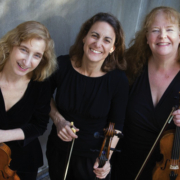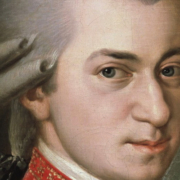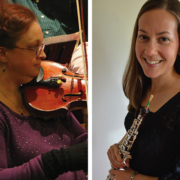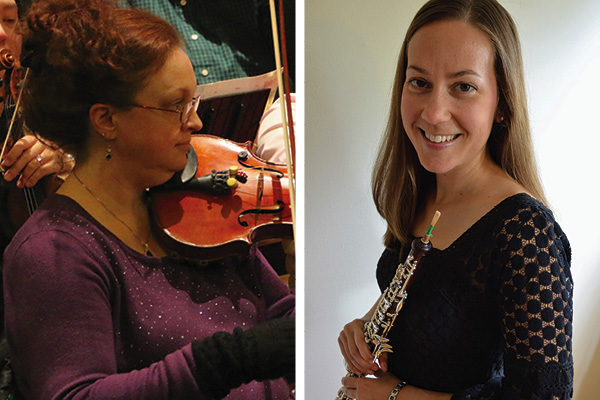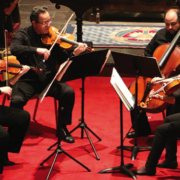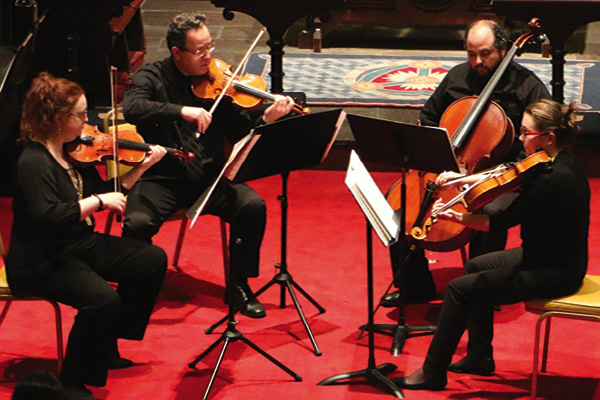WINDS FOR WOLFGANG
March 19 & 20, 2022
Wolfgang Amadeus Mozart
(Born in Salzburg, Austria in 1756; died in Vienna, Austria in 1791)
Die Zauberflöte (The Magic Flute), K. 620
The summer of 1791 found Mozart facing financial ruin and family heartache. His wife was sickly and pregnant, commissions for new works were disappearing for Mozart in fickle-minded Vienna, and he was forced to borrow increasing amounts from friends. What Vienna wanted, and what Mozart needed to change his fortunes, was an operatic “hit.” But there was a glint of hope: Mozart’s old friend Emmanuel Schikaneder proposed an out-of-the-ordinary project: Die Zauberflöte (The Magic Flute). This was a new kind of operetta referred to as a Singspiel (“Singing play”) that incorporated fairy tales, comical entertainment, spoken dialogue and folk-like songs. In the fickle musical circles of Vienna, the success or failure of this operetta was a critical hope-and-gamble moment in Mozart’s career.
Mozart and Schikaneder shared a kinship through their brotherhood in the Freemasons, the secret society of enlightenment that was viewed at the time as hostile to the Roman Catholic Church and even the Austrian state. It’s no surprise, then, to find that the plot of The Magic Flute, though clothed in fairy tales, is an allegory pitting the Freemasons against the Church.
The opera premiered in September 1791 with a libretto by Schikaneder and exquisite music by Mozart. Schikaneder played a lead character (Papageno) and Mozart conducted. The performance was a great success, and The Magic Flute was the “hit” Mozart desperately needed. But he hardly enjoyed this triumph—his unexpected death claimed him only two months later.
The story of The Magic Flute takes place in Egypt (where the Freemasons are thought to have begun), around 1300 BC and revolves around a character named Prince Tamino. While hunting, the prince finds himself entangled in an odd situation: Nearly killed by a giant snake, he’s rescued by three women who are handmaidens to the Queen of the Night. Purely by operatic happenstance, he then finds himself in the company of a bird catcher named Papageno, a curious fellow dressed in feathers. The Queen of the Night asks Tamino to rescue her imprisoned daughter, Pamina, from the dreaded Sarastro, high priest of Isis and Osiris. If the rescue is successful, she says, Tamino may marry Pamina. Tamino is enchanted by this prospect: If the lovely portrait he’s shown of Pamina is accurate, then he’s already in love with her. Tamino agrees to the rescue mission, taking Papageno with him. To ward off harm during their quest, the queen gives Tamino a magic flute and Papageno a set of magic bells. The pair’s journey and friendship allow for plenty of sidebar comedy, but when they get to Sarastro’s Temple, things get serious. The high priest is indeed keeping Pamina, but only to protect her from the evilness of her mother. As surrogate father to Pamina and as Keeper of the Light, Sarastro can see the pureness of Tamino’s heart and agrees to let him wed Pamina, but Tamino and Papageno must first successfully complete a series of tests of their virtue. During these tests the two heroes have plenty of chances to use their magic instruments. When the tests are completed, Tamino and Pamina are allowed into the inner sanctum of the Temple of Isis and Osiris where they are married. And as a finishing touch, the evil queen and her three naughty handmaidens are banished into the ether of the night.
Overture
The Magic Flute garnered extraordinary success within a few days of its premiere and has charmed audiences ever since. Mozart’s score sparkles with the magic and genius of a master at play. The music is appreciable on many levels, from giddy, simple tunes to wonderfully sophisticated moments of complex counterpoint—the whole tied together by exquisite melodies. The overture to this work is a wonderful example of Mozart’s mastery.
Beginning with three ominous chords that represent the sanctity of Sarastro’s realm (the number three also carries a mystical significance for Freemasons), the music then dashes off in a free-spirited fugue, likely representing the journey and comic entanglements of Tamino and Papageno. The chords come back in a new key, and then the fugue begins again, this time with additional counterpoint that marries the seriousness of Sarastro with the lighthearted antics of the fugue theme. On the whole, the overture uses a fairly simple structural design, but in its details, the music is stunningly intricate—here, Mozart uses the bare minimum of themes to create what is considered one of the great overtures of his career.
Der Vogelfänger (I am the bird catcher)
In Act I, Scene 1, Tamino has just been saved from the giant serpent by the Queen of the Night’s three handmaidens but has fainted. Papageno arrives to find Tamino, and begins to jabber, singing one of Mozart’s most merry tunes. “I am the Birdcatcher, indeed!” sings this curious and comical character, who, with lighthearted grousing, complains about not having a wife or even the hint of a girlfriend. Interspersed in his biographical barrage, Papageno plays his panpipe to lure birds for his catching—a simple five note refrain. The aria has always been cherished as a piece of delightful whimsy and lovely tunesmithing by Mozart, and it is a shining example of the wonderful silliness that the new Singspiel was offering to audiences.
Bei Männern, welche die Liebe Fühlen (Those who feel the call of love)
In Scene 3 of Act I, Tamino and Papageno are approaching Sarasato’s temple. Tamino sends Papageno ahead to scope out the situation, and Papageno finds Pamina being held by Sarasato’s chief guard, Monostatos. Monostatos lusts after Pamina, and were it not for Papageno’s blundering into the situation, the guard would likely have abused her. Papageno is terrified at the sight of Monostatos, a dark-skinned Moor, and Monostatos is terrified at the sight of Papageno, a man dressed as a bird, and both run off, leaving Pamina alone.
But Papageno soon returns and tells Pamina about Tamino’s love for her and his plan to rescue and marry her. Pamina is enthralled at the prospect of the handsome prince’s affections. And, of course, Papageno has complained to her about his own pursuit for love, which prompts this lovely duet, “Those Who Feel the Call of Love.” It’s truly a thing of beauty, this duet, which allows each character a chance to discuss the benefits, the sanctity, and the duties of true love. Each stanza is followed by both Pamina and Papageno agreeing in lovely harmony with each other that “nothing is more noble than man and wife.” The tenderness and simplicity of this sweet moment make for some of the most beautiful music in the entire opera.
Le nozze di Figaro (The Marriage of Figaro), K. 492
This was the first of three operas that Mozart collaborated on with the librettist Lorenzo da Ponte, a collaboration that shines as one of the most genius moments in Western music. Through their partnership they created Le nozze di Figaro (1786), Don Giovanni (1787), and Così fan tutte (1790). These three works are regarded as the pinnacle of the Classical opera genre, and Le nozze especially is regarded as the greatest opera buffa ever written.
Da Ponte’s libretto for Le nozze de Figaro was based on the sequel to The Barber of Seville from the “Figaro trilogy” of plays by French playwright Pierre Beaumarchais (1732–1799). Le nozze takes place in Seville, Spain and cleverly casts aspersion on societal ills in a witty and fast-paced setting. In particular, it rather pointedly draws attention to the age-old (but repulsive) tradition of droit du seigneur (“the nobleman’s right”), through which the lord of the manor was allowed to take a woman servant’s virginity on the night before her marriage, as compensation for losing her services. Da Ponte’s texts are clever and often hilarious, tackling the complications created by sex that arise between masters and servants, and although the aftermaths of base behavior are treated with just the right amount of indignation, the overall comic fun of the opera is never completely derailed.
In the prequel story, The Barber of Seville, Figaro is the town barber and general “go-to” man, who paves the way for the characters Rosina and Count Almaviva to marry. Three years later in Le nozze di Figaro, Rosina is now Countess Rosina, married to Count Almaviva, and Figaro has become the count’s servant. Figaro and the countess’s maid, Susanna, are now engaged to be married. However, when Figaro and the countess learn that the count has designs on Susanna, full-scale shenanigans ensue: revenges and counter-revenges are plotted, and characters disguise themselves as one another. Complicating everything is the presence in the manor of a young man of noble status, Cherubino, there to learn good manners while filling the position as the count’s errand boy (his “page”), and who is of such an age of sexual awareness that the countess and Susanna must learn not to treat the lad as a pretty “young plaything” anymore.
Porgi, amor qualche ristoro (Grant [to me], O Love, some Comfort)
Early in Act II, on the eve of Figaro and Susanna’s wedding, Countess Rosina is deeply troubled by Count Almaviva’s scheming to seduce Susanna. Susanna tries to comfort the countess by whitewashing her suspicions, but Figaro has already put a plan into place. He has been sending the count anonymous tips that adulterers are vying for the countess’s affections, and to especially beware this very evening. The hope is that the count will be too busy trying to find phantom suitors than to trouble Susanna. As a backup, Figaro instructs the countess to have Cherubino (the count’s errand boy) dress as Susanna and if necessary, divert the sexual appetites of the count, and possibly catch him red-handed in his infidelities. But alas, it’s all almost too much for the countess, and in her aria Porgi, amor, she wishes for the count’s love to return to her, or at least, for some solace. Porgi, amor is searingly poignant. The countess’s melodies are soaring and beseeching, and Mozart uncannily captures her heart’s torment and exhaustion. Notice, too, Mozart’s exquisite writing for winds in answer to the countess’s pleas, especially the writing for two clarinets, which harken back to sweeter days of the count’s affections. Though fleet, Porgi, amor captures the painful potency of helplessness.
Voi che sapete, che cosa è amor? (You ladies who know what love is…)
Just after the scene in Act II where the countess is pleading for relief (Porgi, amor), Susanna and Cherubino (the count’s errand boy) arrive in the countess’s bedroom. As they begin to prepare Cherubino’s disguise as Susanna to entrap the count, Susanna implores Cherubino to sing his song. Cherubino, a promiscuous lad with an infatuation especially for the countess, has written a tune expressly for her in the grand tradition of the medieval troubadours: Voi che sapete, che cosa è amor? (You ladies who know what love is, is it what I’m suffering from?). Though Cherubino is a young man, this character is what is known as a “breeches role”—cast for a female voice dressed as a (young) man. This is particularly, and comically, apt for this opera which delves into the dignity of gender respect, by re-dressing the woman dressed as a man into a man being dressed as a woman. Despite all the intrigue, drama and wounded feelings that shroud the scene, da Ponte’s lyrics are a superb reminder of the wonder and sweet mysteries of being in love, and Mozart’s musical accompaniment is equally delicate. The strings use only pizzicato (plucked strings) throughout the aria, giving lightness and breathiness to Cherubino’s sentiments. Alongside the strings Mozart adds more richly scored winds, again, with special attention to the clarinets (Mozart’s favorite wind instrument). And atop this tender accompaniment soars a melody of absolute charm.
Dove sono (Where are they?)
Written near the peak of his career, Le nozze di Figaro is one of Mozart’s finest scores, showing his ability to make music mirror the psychological essence of the scene. One of the opera’s most beautiful and thoughtful moments occurs in Act III with the countess’s aria Dove sono (Where are they?). Now, after all the countess’s plotting to catch her husband red-handed in faithlessness in Act II, the time has nigh arrived to see what happens. But in a moment of quiet reflection, she wonders where the sweetness of their love has gone, how she could find herself in such a terrible state of lovelessness and humiliation. And yet she still holds hope with a faintness as fragile as a spider’s web. The beauty of the music is deeply poignant, but Mozart goes a little further. He creates a magic moment out of that beauty, to capture the deep heart suffering of the countess, by repeating the first section at almost a whisper. The psychological effect is disarming: Even as the pathos of the countess’s pain deepens, hopes for reconciliation still gleam distantly.
Serenade No. 10 in B flat major (Gran partita), K. 361
Largo—Allegro molto
Minuet
Adagio
Minuet. Allegretto
Romance. Adagio—Allegretto—Adagio
Theme and Variations. Andante
Rondo. Allegro molto
In 1780s Vienna, music to accompany social engagements was wildly popular. Austria’s newly crowned emperor, Joseph II, was himself very fond of this type of music: music that provided a “background” ambience for socializing. In 1782 one of Joseph’s court musicians, Anton Stadler, the great clarinet virtuoso, encouraged his Freemason brother and friend Mozart to compose some of this music for the emperor. Mozart’s response was an ambitious seven-movement masterpiece, his Serenade No. 10, completed that same year. It’s unclear if Emperor Joseph ever heard this work, however. What is known is that only four movements of it were performed—to great delight—in 1784 under the title of Gran partita, which was added by an anonymous hand. The title has stuck as the nickname for the entire work, which has become greatly beloved.
Mozart’s Serenade uses a string bass and 12 winds: two oboes, four clarinets, two basset horns, two bassoons, and four horns. The basset horn, a popular instrument in central Europe in the 18th century., is a slightly lower-ranged sibling of the clarinet. The choice of these instruments was bold enlargement of the tradition of wind serenade ensembles, and ahead of its time in sonic scope. (In this regard, it seems perhaps that Mozart had envisioned something of a hybrid “serenade” that could also work as a concert piece). Indeed, immediately, in the very first bars of this magical work, when we hear all these instruments together, its soundscape is colossal and stunning—like a grand pipe organ—even orchestral.
The Serenade is a work that fascinates and entertains the listener at nearly every phrase. And though there is much to tell about each of its movements, here are some of its highlights:
The beginning of this masterpiece is a slow and stately introduction, with moments of surprising tenderness. The next section, the molto allegro, is lively and crisp, with some marvelous instrumental combinations and colors. Some of the unison writing, when nearly everyone is playing a propulsion of quick notes, gives a foreshadowing of virtuosic moments throughout the work but especially in one magical moment that will occur during the sixth movement.
This Menuet, a dance movement with two trio episodes, is stately and forthright. The first trio is quite gentle. The second trio, however, beginning with an oboe solo filled with light trills like rippling ribbons accompanied by running triplets in the bassoon, is music of sensuous delight.
This Adagio is one of Mozart’s most beloved musical moments. Heralded by many, and famously celebrated in a priceless scene in the movie Amadeus as the character of Salieri explains that “it seemed to me that I was hearing the voice of God,” this movement is indeed a gem of other-worldly beauty. After a simple introduction that unfolds with deliberate mystery, a solo oboe plays a long, soaring and single note that melts into the clarinet, which then becomes a love duet. It foreshadows the magical beginning of his Requiem (1791), but here in the Serenade it envelopes us in joy.
The sublime loftiness of the Adagio is followed by the next Menuet arriving noisily. Like the earlier Menuet, this one also contains two very contrasting trio episodes: The first one is almost sinister in its minor mode; the second is filled with courtly elegance.
The Romance begins with a moment of gentle sweetness which turns operatically dramatic. The quick middle section teams with intrigue, like the machinations of the count and countess in The Marriage of Figaro.
The Theme and Variations starts with a very agreeable tune. With each variation, more and more rustling occurs in the accompaniment: The same kind of quick-note motive heard in the first movement here becomes increasingly active. That motive morphs into a moment of sheer enchantment in Variation V at about seven minutes into the movement. Here, all the clarinets play similar running fast notes at the quietest of volumes, as if Mozart had transcribed the murmuring of hundreds of bees in a garden—it’s truly mesmerizing.
The Finale is a raucous clamouring of joy. Mozart keeps ramping up the energy and the occurrence of the quick-note motive, and at one point close to the end, everyone but the horns is playing unison notes that fly by at hyper speed. The entire finale is drenched in good cheer, energy and good humor.
© Max Derrickson

